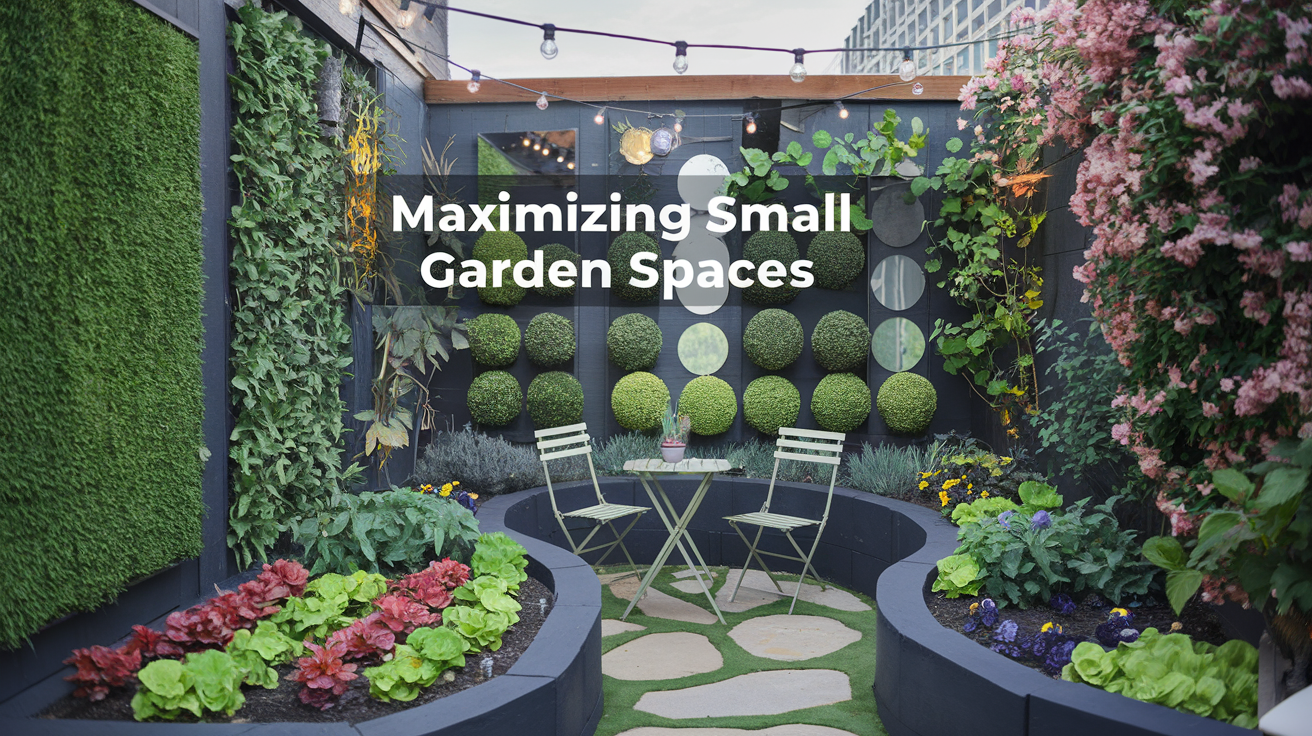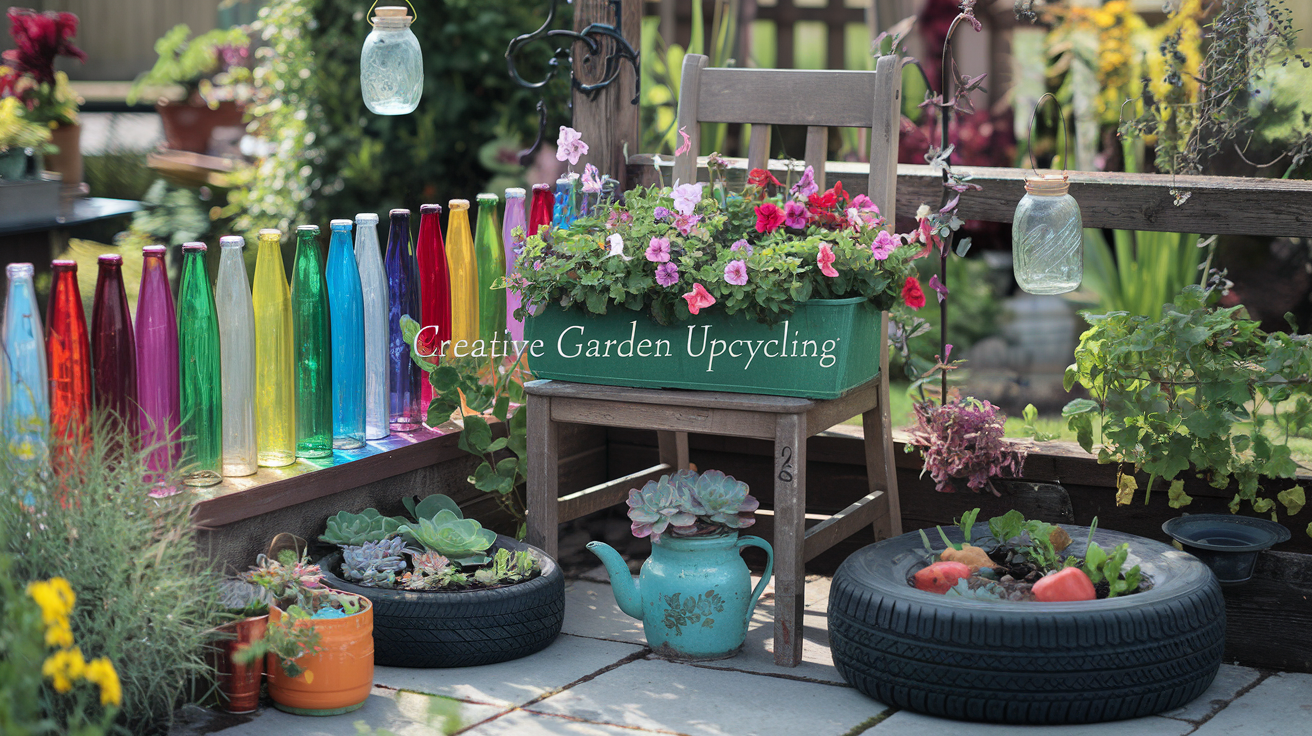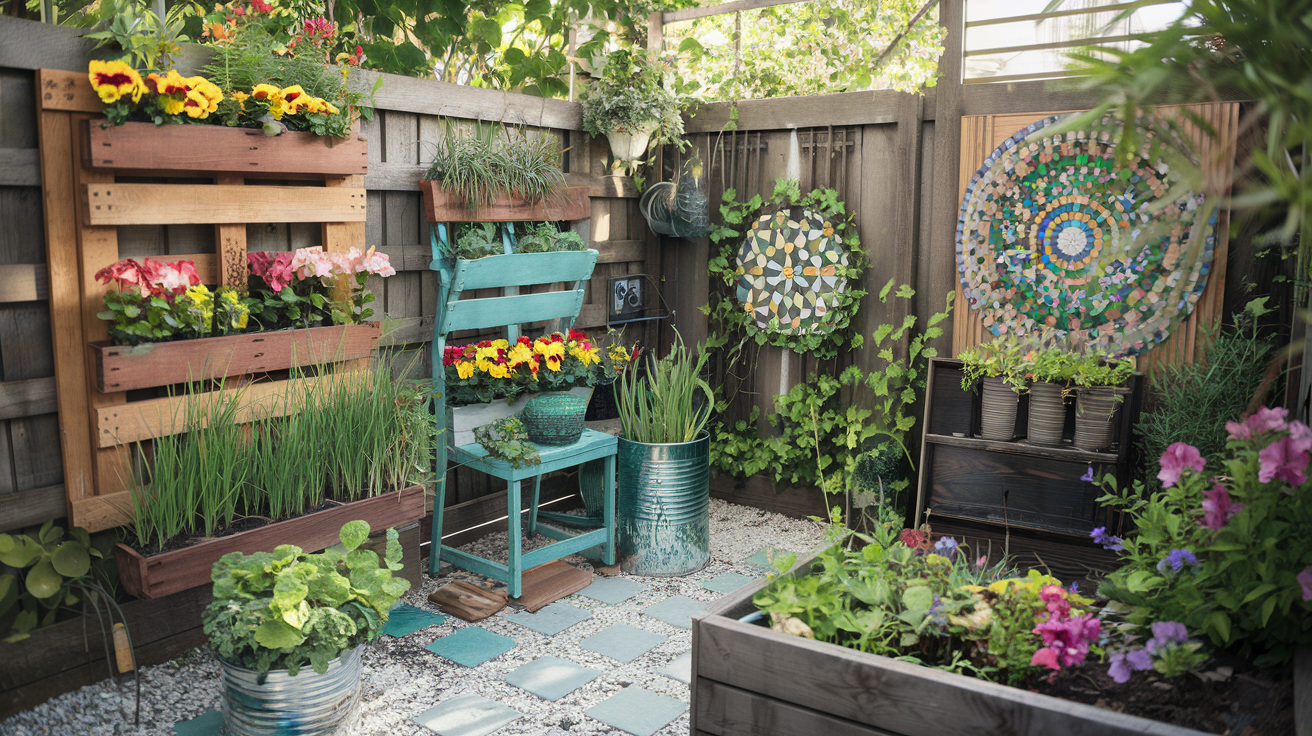What Are the Best Garden Design Ideas for Small Spaces?
Do you gaze longingly at your tiny outdoor area, wondering if it’s even possible to create the garden of your dreams? In today’s urban landscape, where space comes at a premium, many homeowners face the challenge of transforming limited outdoor areas into functional, beautiful sanctuaries. Whether you’re working with a compact balcony, a narrow side yard, or a petite patio, the constraints of a small garden space can feel overwhelming—but they don’t have to limit your creativity or enjoyment.
Small spaces can become extraordinary gardens with the right approach and design techniques. Envision vertical gardens that ascend towards the heavens, ingenious optical illusions that visually enlarge your space, and versatile features that optimize every square inch.. By employing smart plant selection and strategic decorative elements, even the tiniest plot can become a lush, vibrant oasis that reflects your personal style. 🌿✨ In this comprehensive guide, we’ll explore seven transformative approaches to small garden design—from maximizing vertical space to creating the illusion of expansiveness—that will help you turn your compact outdoor area into the garden retreat you’ve always wanted.
Planning Your Small Garden Layout
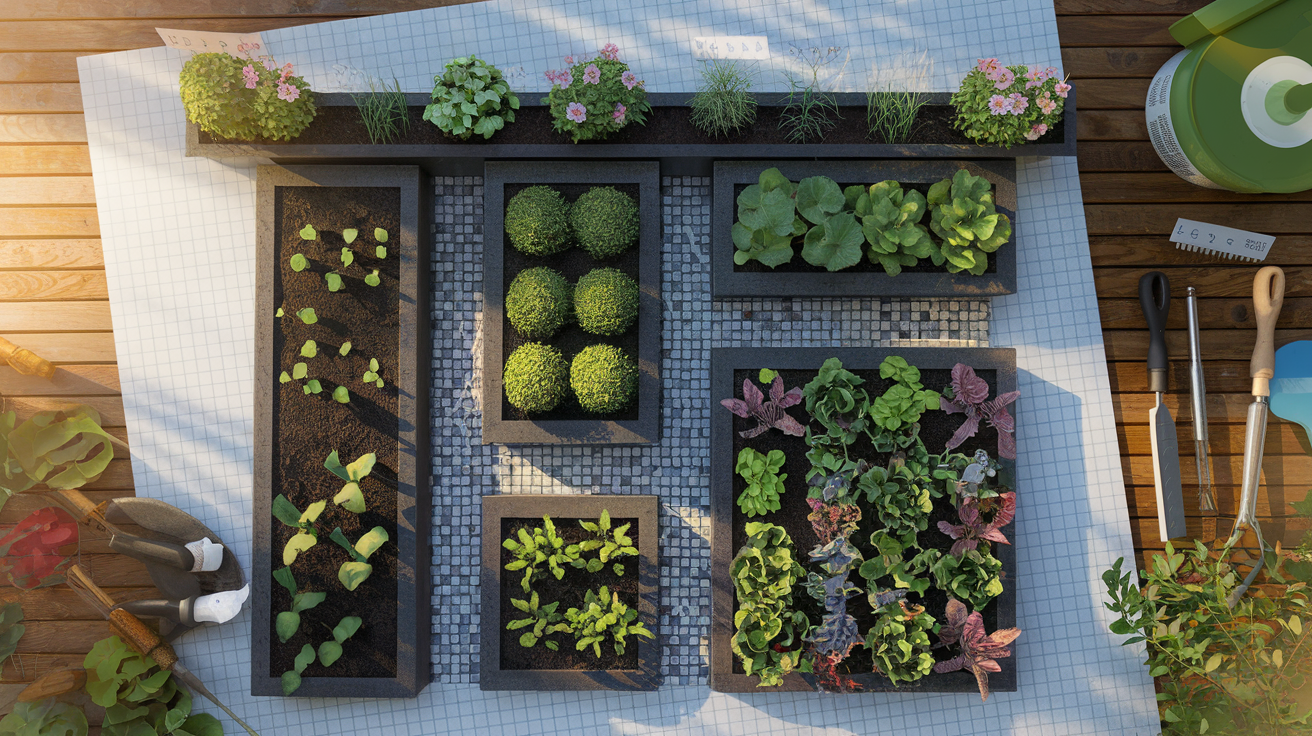
Planning Your Small Garden Layout
Establishing a coherent style or theme
Before diving into the details of your small garden design, it’s crucial to establish a coherent style or theme. This foundational step ensures your garden has a unified look rather than appearing as a random collection of plants. Whether you prefer a cottage garden aesthetic, a modern minimalist approach, or a Mediterranean theme, having a clear vision will guide all your subsequent design choices. A well-defined theme helps create a cohesive color palette and planting scheme that ties the entire space together, making even the smallest gardens feel purposeful and well-planned.
Balancing planting-to-open space ratio
In small gardens, the ratio between planted areas and open space is critical. Overloading your garden with an excessive number of plants can create a sense of clutter and may even make the space appear smaller than its true dimensions. Aim for a balanced approach where plants have room to flourish without overwhelming the space. This might mean being more selective about your plant choices and embracing the concept of “less is more.” Open areas create breathing room and highlight your carefully selected plants, allowing each element to shine rather than compete for attention.
Dividing the garden into sections for intrigue
Even in limited spaces, dividing your garden into distinct sections creates a sense of journey and discovery. These divisions don’t need to be dramatic—even subtle changes in paving patterns or small level changes can effectively delineate different areas. Consider creating “rooms” within your garden, each with its own character and purpose. This approach makes your small garden feel larger as visitors move from one area to another, experiencing different perspectives and focal points along the way.
Creating focal points with island gardens and ornaments
Strategic focal points draw the eye and create visual interest in small gardens. Island gardens—small planted areas surrounded by paving or lawn—can serve as captivating centerpieces. Alternatively, well-placed ornaments like sculptures, water features, or distinctive containers can function as focal points that anchor your design. These elements provide visual destinations that invite closer inspection and create a sense of depth in your garden. Position focal points to maximize their impact from key viewing areas, such as from indoor windows or garden seating areas.
With these foundational layout principles in place, we’ll next explore how to maximize vertical space in your small garden—an essential strategy for expanding your planting options without consuming precious ground area.
Maximizing Vertical Space
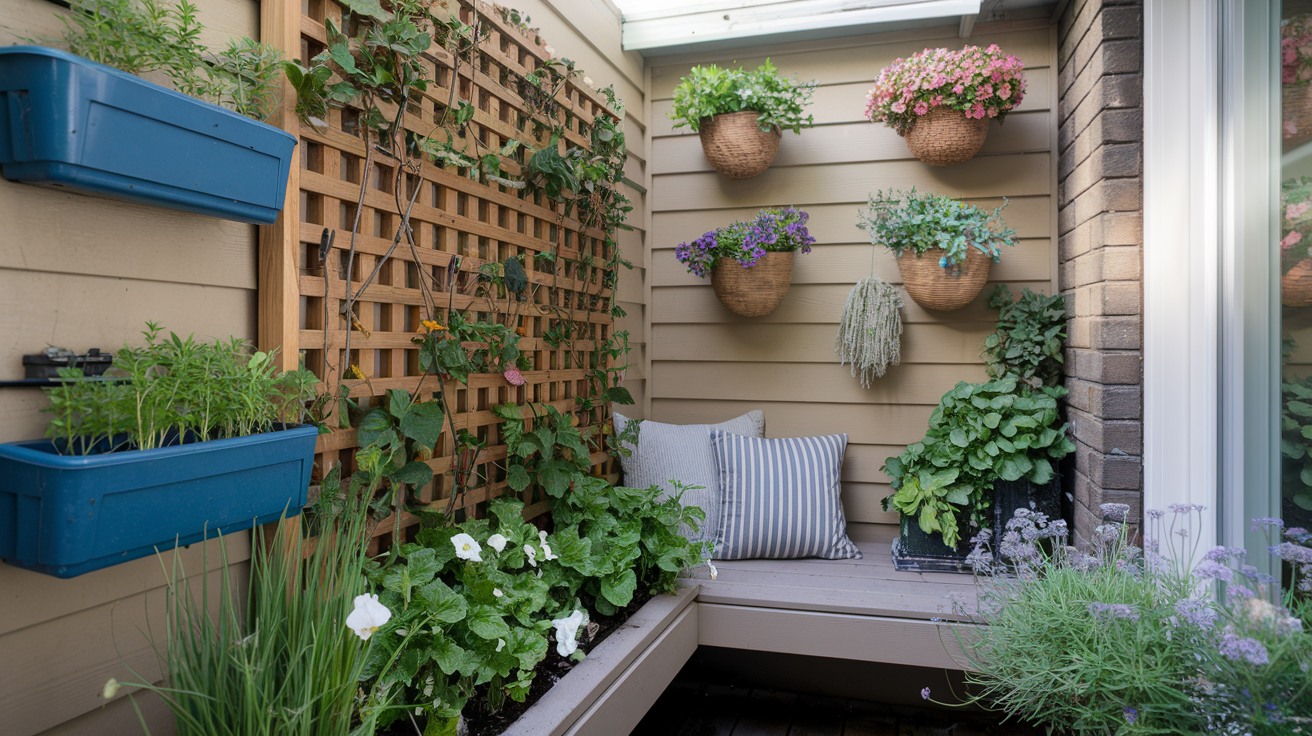
Maximizing Vertical Space
Now that we have planned the layout of your small garden, it’s time to look upward and explore how vertical space can dramatically expand your growing options. Vertical gardening has become increasingly popular among small-space gardeners for good reason—it transforms limited horizontal areas into thriving, multidimensional gardens.
Using tall, narrow plants and trees
When space is at a premium, selecting tall, narrow plants allows you to grow upward without sacrificing valuable ground area. Vining plants and climbing varieties are particularly well-suited for small gardens, requiring minimal floor space while providing maximum yield. Many vegetables that traditionally sprawl across garden beds can be trained to grow vertically, including peas, green beans, and climbing varieties of tomatoes. These plants typically need 6 to 8 hours of direct sunlight, so position them strategically to capture optimal light throughout the day.
Installing trellises and green walls for climbing plants
Trellises, arches, and pergolas create ideal support structures for climbing plants while adding architectural interest to your garden. These structures enable sprawling plants like cucumbers, pumpkins, and winter squash to grow upward rather than outward. For heavier crops such as watermelons and cantaloupes, consider providing additional support like fabric hammocks to prevent fruit from detaching prematurely.
Living walls represent another innovative approach to vertical gardening, transforming ordinary fences or walls into lush, productive growing spaces. These green walls not only maximize growing area but also improve air circulation around plants, which significantly reduces the risk of moisture-related diseases.
Implementing vertical vegetable planters
Vertical vegetable planters offer a structured approach to growing edibles in tight spaces. Commercial vertical planters often feature built-in watering systems, making maintenance more efficient. Alternatively, DIY options like pallet planters can be repurposed to grow herbs and compact vegetables along walls or fences.
For indoor spaces, containers attached to boards or wall-mounted pots allow fresh herb cultivation without consuming counter space. These systems are particularly valuable for maintaining a year-round herb garden in small apartments or homes with limited outdoor access.
Adding height with mixed arrangement containers
Mixed arrangement containers stacked or tiered at varying heights create visual interest while maximizing growing potential. These versatile planters can accommodate different plant types in the same footprint, effectively layering your garden vertically. Consider combining plants with complementary growth habits—tall specimens at the back or center surrounded by trailing varieties that cascade over edges.
When planning container arrangements, remember that vertical gardens often require more frequent watering due to increased exposure to wind and potential rain shadows. Installing micro-irrigation or drip systems can ensure consistent moisture delivery without the need for constant manual watering.
With these vertical gardening strategies in place, your small space can yield surprisingly abundant harvests while maintaining visual appeal. In the next section, we’ll explore techniques for creating the illusion of space, which will further enhance the perceived dimensions of your compact garden area.
Creating the Illusion of Space

Creating the Illusion of Space
Now that we’ve covered how to maximize vertical space in your small garden, let’s explore techniques to create the illusion of a larger area. With clever design choices, you can make your compact garden feel more expansive and inviting.
Using light colors in hardscaping and plant selection
Lighter hues inherently reflect a greater amount of light, which creates the illusion of larger and more spacious areas.. When selecting materials for your hardscaping elements like patios, walls, or paths, opt for lighter shades such as cream, soft gray, or beige. Similarly, incorporate plants with light-colored foliage or flowers to brighten the space. Light-colored garden furniture and decorative elements also contribute to this spacious feeling, creating a cohesive and airy atmosphere throughout your garden.
Incorporating mirrors to visually expand the area
Mirrors are powerful tools for creating depth and dimension in small gardens. A strategically placed mirrored garden fence can reflect greenery and create the illusion of a space that extends beyond its actual boundaries. For a whimsical touch, integrate mirrors with climbing vines or surround them with plants. Reflective water features serve a similar purpose, doubling your garden’s visual appeal while enhancing its tranquility. When placing mirrors, consider what they will reflect – ideally, you want them to capture attractive plantings or garden features rather than blank walls.
Designing curved paths to create intrigue
Unlike straight pathways, curved or diagonal paths create a sense of journey and discovery in your garden. These winding routes naturally draw the eye through the space, making it feel larger and more interesting. Consider creating an optical illusion pathway using diagonal or slanted stones to visually expand the garden. Patterns like zigzags or alternating colors can enhance this effect. Curved paths also divide the garden into zones, which paradoxically makes the overall space feel larger by creating multiple “rooms” within your garden.
Ensuring distance between living areas and gardens
Creating distinct zones in your garden helps establish a sense of depth and perspective. Position seating areas away from the main garden features to create distance and force the eye to travel across the space. A floating deck separated from the main planting areas can serve as a cozy retreat while enhancing the perception of space. Similarly, a hidden bench tucked behind plants or structures provides a secluded spot that makes the garden feel more expansive as visitors discover new areas.
With these illusion-creating techniques in place, you’ll be ready to enhance your garden further with smart plant selection. The right plants can complement these spatial illusions while thriving in your compact garden environment.
Smart Plant Selection for Small Gardens
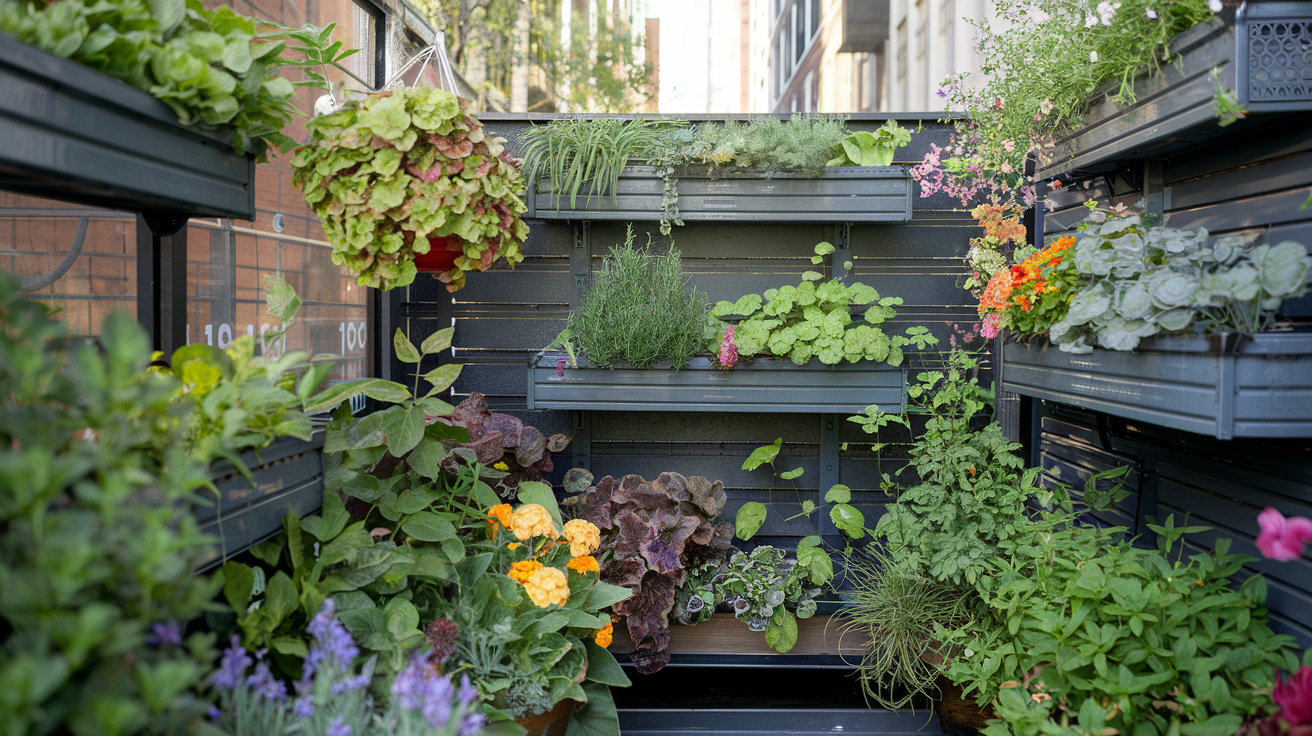
Smart Plant Selection for Small Gardens
Now that we’ve explored how to create the illusion of space in your small garden, it’s time to focus on what to actually plant in these compact areas. Strategic plant selection is crucial for maximizing limited square footage while still achieving a beautiful and functional garden.
——–
Choosing Compact Fruits and Vegetables
Small gardens can still yield delicious harvests with the right selections. Leaf lettuce is an excellent choice as it allows for quick regrowth after harvesting. Peas can be maximized in small spaces when grown vertically on trellises, offering not just pods but edible shoots and tendrils as well. Miniature tomatoes and cucumbers thrive when trained to grow upward, producing flavorful yields without sprawling across your limited ground space. Even winter squash varieties like butternut can flourish in compact gardens when supported by sturdy trellises.
For herbs, Thai Basil and Oregano deliver excellent culinary value while maintaining compact growth habits. Dwarf rosemary and summer thyme add both fragrance and flavor to your garden without demanding excessive space.
Including Evergreens for Year-Round Interest
Evergreen plants ensure your small garden remains visually appealing throughout all seasons. Pittosporum tenuifolium ‘Tom Thumb’ offers beautiful plum-colored leaves in a compact evergreen form. Sarcococca confusa provides fragrant winter blooms when little else is flowering, making it a valuable addition to small spaces. For vertical interest with evergreen appeal, consider Star Jasmine, which delivers both fragrance and year-round foliage while taking up minimal ground space.
Using Geometric Plants for Structure and Formality
Structural plants with defined shapes create a sense of order in small gardens. Lily Turf forms neat clumps with glossy dark green leaves and lavender-and-white flowers, thriving in zones 4 to 10. Allium Serendipity delivers upright blue-green foliage topped with perfectly round purple flower clusters, reaching just 20 inches in height while providing strong visual structure. These geometric forms create natural focal points and establish a sense of formality without overwhelming the space.
Creating Depth with Varied Plant Textures and Colors
Layering different textures and colors creates visual depth in limited areas. Orchid Frost Lamium offers striking foliage with delicate pink summer blooms, while Caramel Coral Bells contribute vibrant peach-gold leaves with cream-colored flowers. Heuchera ‘Georgia Peach’ adds rich texture without dominating the garden.
For seasonal color, incorporate Snowcap Shasta Daisy with its cheerful yellow-and-white blooms. Hydrangea arborescens ‘Annabelle’ provides large creamy flowers that make a statement without requiring excessive space. Cineraria offers unique texture, while carefully selected Acer species deliver vibrant autumn foliage in a compact form.
With thoughtful plant selection complete, we’ll next explore functional features that can further enhance your small garden space. These practical elements will complement your plant choices while adding utility to your compact outdoor area.
Functional Features for Limited Spaces
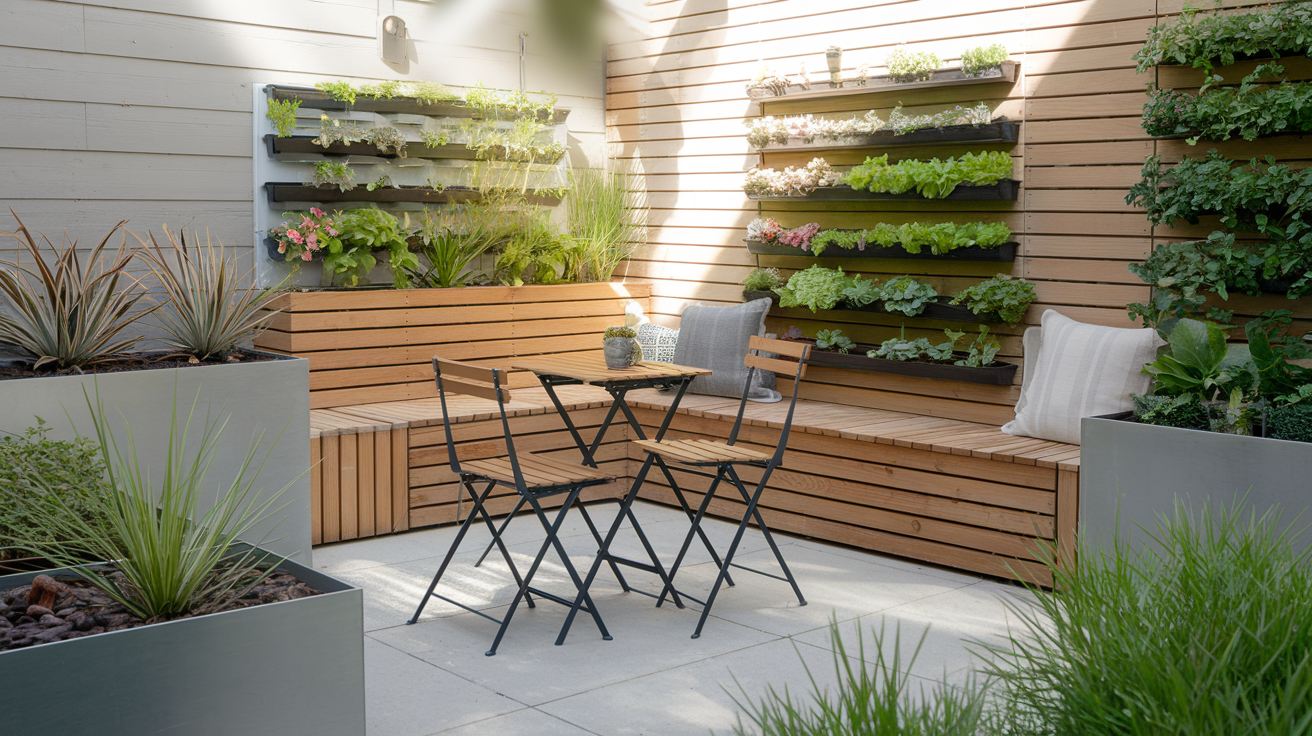
Functional Features for Limited Spaces
Now that we’ve covered smart plant selection for small gardens, it’s time to focus on incorporating functional features that maximize your limited space while enhancing usability. With thoughtful planning, even the smallest garden can become both beautiful and practical.
Selecting space-saving furniture
Multi-functional furniture is key to optimizing small gardens without sacrificing style or comfort. Consider options like:
- Benches with built-in storage compartments for garden tools or cushions
- Collapsible tables and chairs that can be stored away when not in use
- Compact seating arrangements that provide comfort without overwhelming the space
- Strategically arranged furniture that maintains good flow throughout the garden
These space-conscious choices allow you to enjoy your garden functionally while preserving precious square footage. For balconies, select compact planters alongside cozy seating to create a relaxing retreat in minimal space.
Installing clever paving designs for perspective
The right paving can significantly impact how spacious your garden feels:
- Established pathways provide organization and direct navigation throughout the area
- Light-colored paving materials reflect light and create a sense of openness
- Diagonal patterns can make narrow spaces appear wider
- Using varied textures adds visual interest without taking up additional space
Well-designed paving not only serves a practical purpose but also contributes to the illusion of a larger garden through thoughtful perspective techniques.
Incorporating multi-functional garden elements
Make every element in your garden work double-duty:
- Trellises that provide both support for climbing plants and create privacy screens
- Raised beds that serve as both planting areas and casual seating edges
- Vertical structures that function as garden dividers while supporting climbing plants
- Small water features that add tranquility while serving as focal points
- Edible plants that offer both visual appeal and practical harvests
Repurposed items can also serve as creative multi-functional elements—old dressers transformed into planting bases or gutters repurposed as hanging gardens maximize space while adding unique character.
Using raised garden beds for easier maintenance
Raised beds offer numerous advantages for small gardens:
- Improved organization of plants in limited spaces
- Better drainage and reduced soil compaction
- Easier access for maintenance without bending or kneeling
- Clear boundaries that help prevent plants from sprawling
- Options for tiered arrangements to accommodate more plants vertically
For extremely limited spaces like decks, elevated garden boxes provide a practical solution while creating visual interest through varying heights.
With these functional features in place, your small garden will maximize every inch while remaining practical and enjoyable. Next, we’ll explore how to enhance your small garden with decorative elements that add personality and charm without sacrificing valuable space.
Enhancing Small Gardens with Decorative Elements

Enhancing Small Gardens with Decorative Elements
Now that we’ve covered functional features for small spaces, it’s time to explore how decorative elements can transform your compact garden into a visually stunning retreat. The right decorative touches not only enhance aesthetics but also contribute to the overall feel of your garden.
Developing a Cohesive Color Theme
A cohesive color theme is essential for small gardens to avoid a cluttered appearance. When working with limited space, too many disparate colors can create visual chaos. Instead:
- Select a harmonious palette of 2-3 primary colors for your plants and decorative elements
- Use light colors to create the illusion of spaciousness
- Consider colorful furniture pieces that maintain vibrancy even during off-season periods when fewer plants are blooming
- Incorporate plants with varied textures within your color scheme to add depth and interest
The strategic use of color creates visual harmony and makes your small garden appear more organized and intentionally designed.
Creating Inviting Entrances with Garden Gates
An inviting entrance sets the tone for your entire garden experience. Garden gates serve as both decorative elements and functional transition points:
- Utilize a garden gate to delineate the entrance to your compact garden
- Select a gate style that complements your overall garden theme
- Consider climbing plants around the entrance to create a lush, welcoming feel
- Use the gate area to establish focal points that draw visitors into the space
A thoughtfully designed entrance creates anticipation and makes even the smallest garden feel like a special destination.
Personalizing with Garden Decor
Personal touches through garden decor allow you to express your unique style while enhancing your small space:
- Place bold ornaments centrally in island gardens to create focal points
- Use large containers with tall plants placed centrally to create a sense of abundance
- Select decor pieces that reflect your personality while complementing your garden’s style
- Incorporate multi-functional decorative elements that serve practical purposes
Remember that in small spaces, each decorative element should earn its place through both beauty and purpose.
Adding Strategic Lighting for Evening Ambiance
Proper lighting extends the enjoyment of your garden into the evening hours and creates magical ambiance:
- Install path lights to highlight curved walkways
- Use uplighting on vertical elements like trees to create depth
- Place soft lighting around seating areas for evening enjoyment
- Consider string lights or lanterns to add a festive feel to outdoor dining spaces
Strategic lighting not only improves the evening atmosphere but also increases the functional hours of your garden area..
With these decorative elements in place, your small garden can achieve both beauty and function. Next, we’ll explore specialized garden ideas for small spaces that can help you maximize your compact area with creative themed approaches tailored to your specific interests and needs.
Specialized Garden Ideas for Small Spaces

Specialized Garden Ideas for Small Spaces
Now that we’ve explored how to enhance small gardens with decorative elements, let’s delve into specialized garden ideas that can transform limited spaces into unique and functional areas. These specialized approaches allow you to maximize both beauty and utility, even in the smallest of gardens.
Creating Themed Gardens (Tea, Vegetable, Herb)
Themed gardens offer a focused approach to small space gardening. A tea garden featuring chamomile, mint, and lemon balm creates both beauty and functionality. Herb gardens can be arranged in tiered planters or wall-mounted containers, providing fresh culinary ingredients while saving valuable ground space. Vegetable gardens can be designed with companion planting principles to maximize yield in minimal space. The key is establishing a clear theme before planning, which creates a cohesive look and prevents the cluttered appearance that can make small spaces feel even smaller.
Designing Container Gardens Instead of Traditional Lawns
Container gardens offer tremendous flexibility for small spaces, eliminating the need for traditional grass lawns. Using a variety of containers – from terracotta pots to repurposed items – allows you to create distinct garden areas with different plant groupings. This approach enables you to:
- Move plants seasonally to optimize sun exposure
- Create mixed arrangements with complementary colors and textures
- Experiment with different plant combinations without major renovations
- Incorporate height variation using stands and pedestals to enhance visual appeal
Containers also make it easier to maintain soil quality and control pests in your small garden environment.
Planting Potted Fruit Trees for Edible Landscapes
Even without extensive ground space, you can enjoy the benefits of fruit trees. Dwarf and compact varieties of apples, citrus, and other fruits thrive in large containers, making them perfect for small gardens. These potted trees serve multiple purposes:
- Providing edible produce in limited spaces
- Creating vertical interest and structure
- Offering seasonal interest through blossoms, fruit, and foliage
- Defining garden areas and creating natural focal points
Position fruit trees strategically to maximize sunlight exposure while creating shade for heat-sensitive plants beneath them.
Planning for Seasonal Interest Throughout the Year
A well-designed small garden offers visual appeal in every season. Incorporate plants with different blooming periods and evergreens for year-round structure. Consider these strategies:
- Select plants that provide autumn color and winter berries
- Include early spring bulbs that emerge before other plants leaf out
- Layer plantings with different bloom times for continuous color
- Use ornamental grasses that provide movement and winter interest
- Add lighting to highlight garden features during darker months
By carefully selecting plants with sequential interest, your small garden will remain vibrant and engaging throughout the changing seasons, creating a dynamic outdoor space that evolves throughout the year.
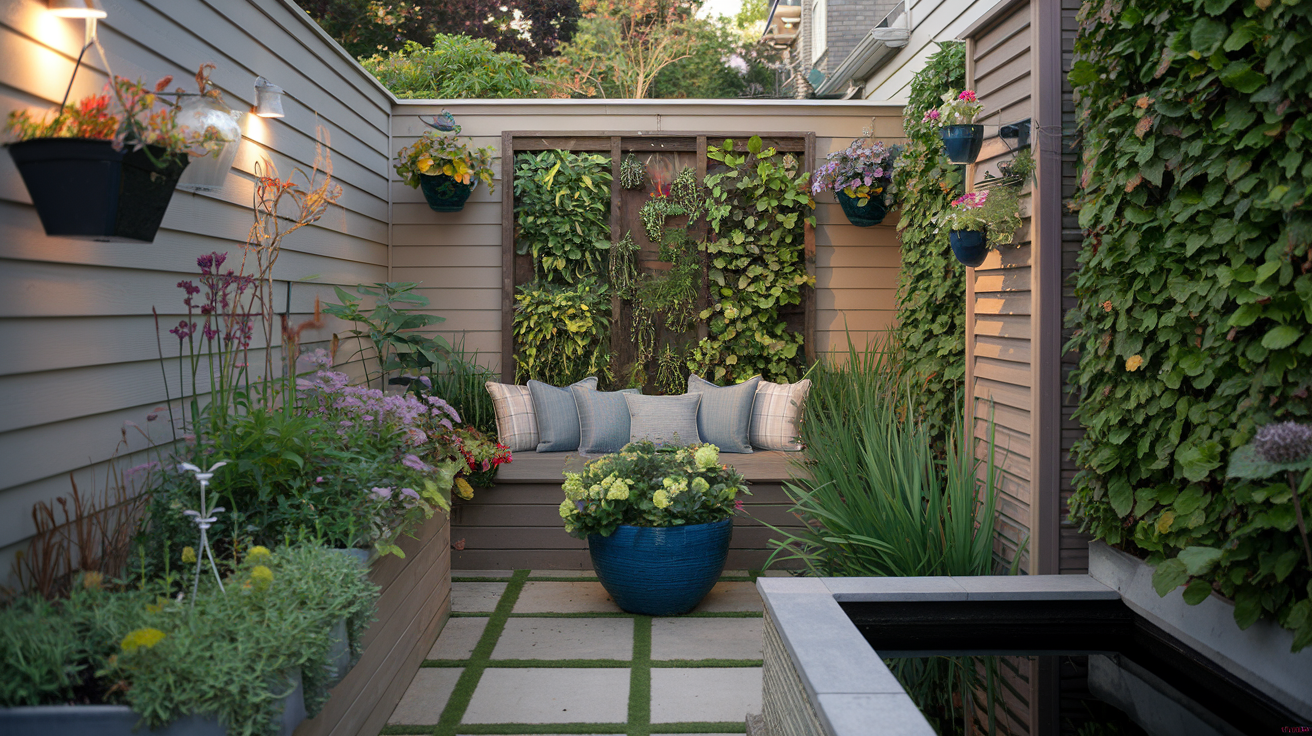
Small gardens offer endless possibilities for creativity and functionality when approached with the right mindset. By carefully planning your layout, maximizing vertical space through trellises and wall planters, and creating the illusion of space with clever design techniques like curved pathways and strategically placed mirrors, you can transform even the tiniest outdoor area into a stunning retreat. Smart plant selection—focusing on compact varieties and those with year-round interest—coupled with functional features like foldable furniture and multi-purpose elements ensures your garden remains practical while maintaining visual appeal.
Keep in mind that your modest garden reflects your individual style. Whether you choose to create a themed space such as a tea garden, embrace vertical vegetable growing, or simply incorporate decorative elements that bring you joy, the key is thoughtful planning and design. With the ideas presented in this guide, you can create a small garden that feels surprisingly spacious, remains visually captivating throughout the seasons, and provides a delightful outdoor sanctuary that proves limited space need never limit your gardening ambitions.
What Are the Best Garden Design Ideas for Small Spaces?
